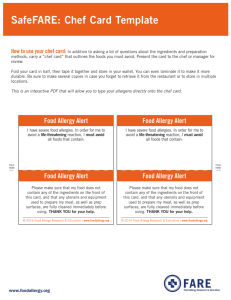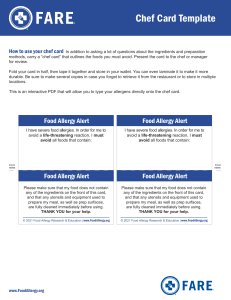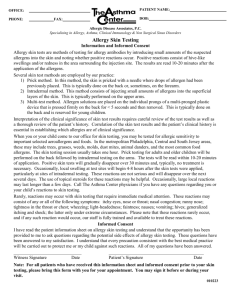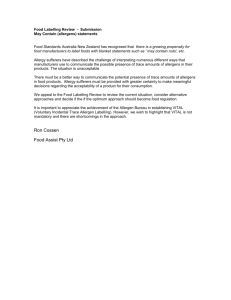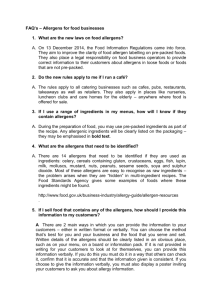RESTAURANTS AND FOOD ALLERGY
advertisement
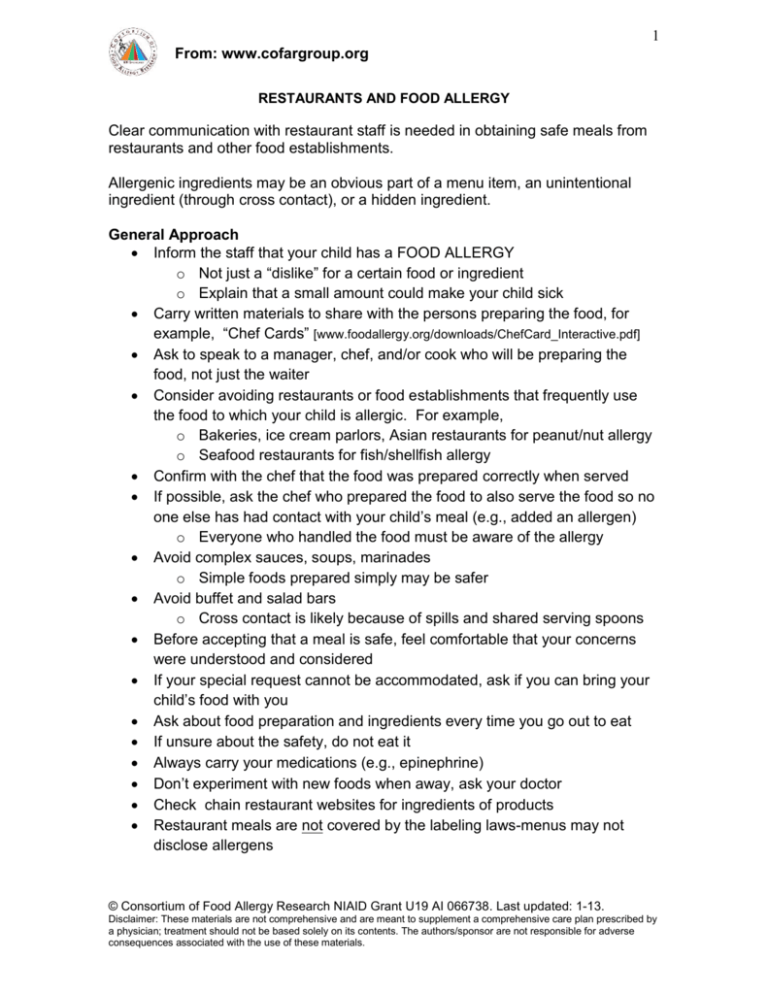
1 From: www.cofargroup.org RESTAURANTS AND FOOD ALLERGY Clear communication with restaurant staff is needed in obtaining safe meals from restaurants and other food establishments. Allergenic ingredients may be an obvious part of a menu item, an unintentional ingredient (through cross contact), or a hidden ingredient. General Approach Inform the staff that your child has a FOOD ALLERGY o Not just a “dislike” for a certain food or ingredient o Explain that a small amount could make your child sick Carry written materials to share with the persons preparing the food, for example, “Chef Cards” [www.foodallergy.org/downloads/ChefCard_Interactive.pdf] Ask to speak to a manager, chef, and/or cook who will be preparing the food, not just the waiter Consider avoiding restaurants or food establishments that frequently use the food to which your child is allergic. For example, o Bakeries, ice cream parlors, Asian restaurants for peanut/nut allergy o Seafood restaurants for fish/shellfish allergy Confirm with the chef that the food was prepared correctly when served If possible, ask the chef who prepared the food to also serve the food so no one else has had contact with your child’s meal (e.g., added an allergen) o Everyone who handled the food must be aware of the allergy Avoid complex sauces, soups, marinades o Simple foods prepared simply may be safer Avoid buffet and salad bars o Cross contact is likely because of spills and shared serving spoons Before accepting that a meal is safe, feel comfortable that your concerns were understood and considered If your special request cannot be accommodated, ask if you can bring your child’s food with you Ask about food preparation and ingredients every time you go out to eat If unsure about the safety, do not eat it Always carry your medications (e.g., epinephrine) Don’t experiment with new foods when away, ask your doctor Check chain restaurant websites for ingredients of products Restaurant meals are not covered by the labeling laws-menus may not disclose allergens © Consortium of Food Allergy Research NIAID Grant U19 AI 066738. Last updated: 1-13. Disclaimer: These materials are not comprehensive and are meant to supplement a comprehensive care plan prescribed by a physician; treatment should not be based solely on its contents. The authors/sponsor are not responsible for adverse consequences associated with the use of these materials. 2 From: www.cofargroup.org Review concerns for “Cross-Contact” and “Hidden Ingredients” with Restaurant Personnel Cross contact occurs when a “safe” food comes in contact with an “unsafe” food. As a result, an otherwise safe food now contains the allergen. This occurs because of spills, shared kitchen equipment (pots, food processors, fryers, and grills), and shared utensils (spoons, knives, spatulas, tongs). Examples: meat sliced on a cheese slicer causes milk contamination cookie sheets in bakeries serving utensils on salad bars, ice cream shops, and cafeteria lines (food allergens may be spilled on safe foods) grills use for eggs, cheese or fish followed by safe foods fryers used for various allergens (fryer heat does not destroy an allergen) Hidden ingredients are not noticeable and may only be known to the person who prepared the food. Ingredients may also change from time to time. Examples: Nuts or nut oils added to salad dressings and sauces Food decorations may contain allergen (e.g., peanut candy “eyes”) Peanut butter/flour added to sauces, gravies or marinade recipes for thickening Milk (butter or margarine containing milk protein), egg, and/or wheat in sauces Butter added at the end of grilling Eggs used in casseroles or to help bind ground meat like meatballs Fish used in sauces Additional Tips Call or visit the restaurant ahead of time without your child when the manager or chef is not busy to determine if safe meals can be obtained Wipe eating surfaces with cleaning wipes Simply washing an ice cream scoop may not be enough to avoid crosscontact because ice cream containers may have been contaminated with allergens from previous scoops-soft serve may be a better choice Consider bringing a safe meal with you If there is a mistake (e.g., nuts on a salad), consider leaving, or hold the problem dish until a new safe dish is delivered and explain what is needed to make a new safe one (e.g., picking off the nuts is not good enough). If a reaction occurs, tell the establishment and get a list of all the ingredients to review with your doctor RESOURCES -This program has additional information sheets that you may find helpful -Explore additional educational materials, for example, from Food Allergy Research & Education (www.foodallergy.org) including downloadable “Chef Cards” © Consortium of Food Allergy Research NIAID Grant U19 AI 066738. Last updated: 1-13. Disclaimer: These materials are not comprehensive and are meant to supplement a comprehensive care plan prescribed by a physician; treatment should not be based solely on its contents. The authors/sponsor are not responsible for adverse consequences associated with the use of these materials.
